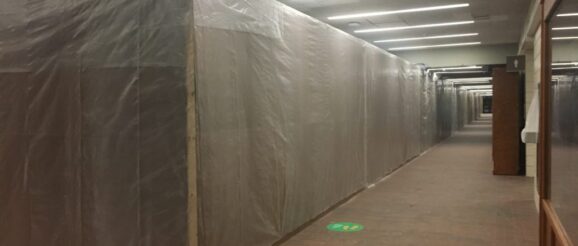State-of-the-art Engineering Innovation Hub to open on campus this spring // The Observer

At the end of April, 10,000 square feet of construction space in Cushing Hall of Engineering will be unveiled to reveal the Engineering Innovation Hub (EIH) — a project that has been in the works for 18 months.
The EIH is part of iNDustry Labs — the Notre Dame partner under a larger network called LIFT, which aims to enhance regional industry in the larger South Bend-Elkhart area — and has been in the works for four years.
 Isabella Volmert | The Observer
Isabella Volmert | The Observer Currently under construction in Cushing Hall, the Engineering Innovation Hub will offer 10,000 square feet of technologies when it opens in April.
In the spring of 2019, the LIFT network received a $42 million grant to create a structure for economic development in the region, professor of electrical engineering and iNDustry Labs faculty director Tom Fuja said.
The hub’s emphasis on regional development expands its mission beyond education and research, Fuja noted.
“It also is going to have an outreach mission, in that there’s going to be some capabilities in this facility, some tools, some equipment that is going to be a potential interest value to regional companies,” Fuja said.
Polymer 3D printers, 3D metal and ceramic printing equipment, robotics equipment and Haas Computer Numeric Control (CNC) machines are some of the state-of-the-art equipment that will be provided in the hub.
“This is absolutely going to be top quality tools, as good as or better than you’re going to find in industry and it’s really going to help prepare students to go out and take leadership roles in the industry,” Fuja said.
The installation of large windows will make the finished facility a showpiece, he added.
“It’s going to be a marquee facility,” Fuja said. “It’s going to be something that we really want to show off to people, to show them what kinds of facilities that we have here, and how important this is to engineering at Notre Dame.”
Professor of engineering David Go said individuals who wish to use the hub’s technologies will be given specific training.
“It is not a 24-hour, anyone can use anytime facility, but any student can use it as long as they go through the training process and follow all protocols,” Go said.
Daryl Peterson was recently named the first managing director of the EIH and will bring with him a legacy of engineering experience, as well as the “heart of a teacher,” Fuja, chair of the hiring committee, said.
“We wanted … somebody who isn’t just going to be a faculty member, who has spent their whole life in academia but brings that manufacturing, that industry experience, but at the same time, really loves teaching, really loves explaining things,” Fuja said.
An Indiana native, Peterson earned his Bachelors of Science in mechanical engineering from Rose-Hulman and hopes to be able to share engineering and career advice with students he encounters in the EIH. He landed the job after spending 25 years in the manufacturing industry at Ford and John Deere.
“I thought if I was going to give back to the students using my real-world, practical experience, this seemed like the perfect role, in my mind,” Peterson said.
Peterson said his primary responsibilities as managing director will be to first get the hub up and running and then collaborate with faculty and local industry partners.
Although he is new to the South Bend and Notre Dame community, Peterson wants to help Notre Dame better achieve a status of world-class engineering in his new role, as well as encourage students to expand their knowledge and skillset while they are in college.
“We have a lot of super smart engineers coming out of Notre Dame, and the question is: How do we get them to make that next step to get comfortable where they look across disciplines?” Peterson said.
Phase two of the EIH will be the next step in upgrading the facility, and if the budget allows, Peterson said he hopes to see an emphasis on artificial intelligence and advanced manufacturing in the additions.
As a class of 2001 Notre Dame College of Engineering graduate, Go said he hopes the EIH will give students a better understanding of how things are made than he had after his undergraduate years.
“What I am most excited about is providing Notre Dame students with the tools and facilities they need to really understand how things are made — what it means to take something on paper and fully realize it in three dimensions in a truly functional way,” Go said. “The best way they can learn that is to build things themselves.”
The facility will showcase the skills and work of engineering students, but Go said he is most excited for the projects that will come out of individuals gravitating toward the lab to work on their passion projects, not necessarily for a course.
“The ones by our many engineering clubs, the ones by students for start-ups that they’re doing through the IDEA Center, the ones which students are doing with local partners and collaborators and the ones I can’t even think of because I’m not as innovative as they are,” Go said. “Those are the projects that will really showcase Notre Dame engineers.”
